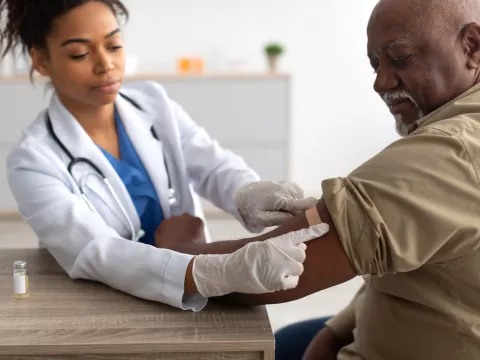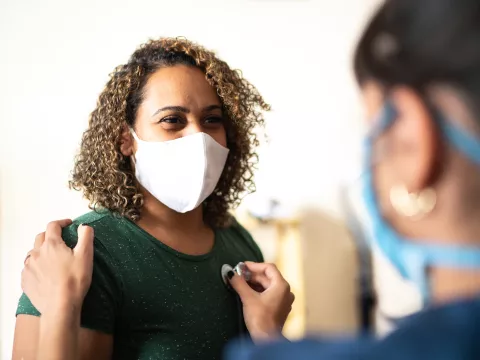- AdventHealth

Rolling Stones frontman Mick Jagger, 75, is having heart surgery to replace a heart valve this week. Despite the seriousness of his condition, reports say he’s expected to make a quick recovery and return to his tour within a few weeks.
It may seem surprising, but thanks to advanced non-invasive heart surgery techniques, patients can bounce back faster than ever before. No longer does a heart condition require open heart surgery.
Rather, these new procedures take an hour to complete, and you could be released from the hospital within 24 hours.
Here’s what you should know about heart valve diseases and the cutting-edge technology that’s used to treat them.
What are Heart Valve Diseases?
Picture what water looks like flowing out of your tap when you turn it on. This is a good representation of how your heart manages blood flow through your valves.
Now imagine what might happen if your drinking water had to flow through narrower and narrower pipes.
When it happens in your aorta, the biggest artery in your body, this is called aortic stenosis. It requires the heart to work harder, which over time can lead to heart failure. The condition is often fatal.
A similar kind of problem happens when another heart valve leaks, meaning blood flows the wrong way. It, too, can lead to heart failure.
Taken together, heart valve diseases are some of the most common but serious heart disorders, affecting about five million Americans. Even when they don’t cause heart failure, valve disorders can cause severe tiredness and shortness of breath, robbing people of the activities they enjoy the most.
Though some medication and lifestyle changes can slow the damage to our heart, surgery is the only cure. And, until recently, the older adults most likely to have these diseases were the ones who were often not healthy enough to have open-heart surgery.
But new options to treat valve disorders have emerged in recent years that don’t require open-heart surgery. Instead, small devices are threaded into the heart using small incisions, usually made in the groin.
AdventHealth has a team of board-certified cardiologists who employ leading-edge services and the latest technology to treat heart valve disorders. That includes transcatheter aortic valve replacement, or TAVR, and MitraClip®.
Both of these procedures have given new hope to patients for whom open-heart surgery is too risky. They also offer much shorter recovery times, measured in days instead of weeks. Most importantly, they save lives. And they let people keep living the life they choose.
Listen to Your Heart
At first, diagnosing heart valve failure is difficult. The heart reacts to a clogged or leaky valve by working harder, and symptoms can be minor or non-existent. Eventually, though, a person may notice some of the following:
- Chest pain, pressure or tightness, especially with activity
- Weakness or dizziness
- Fatigue (feeling very tired without a good reason)
- Swelling of the feet or ankles
If you suspect you have a heart valve problem, it’s crucial to talk to your doctor soon. These problems will only get worse on their own.
One heart valve condition, called aortic stenosis, is so serious that patients with severe cases have survival rates of as low as 50 percent after two years. That makes it a more deadly disease than most forms of cancer.
Thinking about needing a procedure to mend your heart valves is enough to provoke anxiety in anyone. Fortunately, new alternatives are offering the promise of less-invasive options.
Extremely Fast Recovery Times
The aortic valve is the last stop for blood in the heart before it’s shuttled out into the rest of the body.
If we think back to the metaphor with tap water, aortic stenosis happens as that water pipe gets more and more blocked. When the valve can’t open all the way, less blood makes it through. This means the heart has to work harder. And, unlike other muscles that get healthier with exercise, the heart gets damaged.
For a long time, the only way to cure aortic stenosis was with surgery to cut out and replace the narrow valve. But TAVR works differently.
Using this new method, a tiny man-made valve is attached to a small balloon and inserted through a blood vessel in the leg. The device is threaded up into the aortic valve and the balloon inflates, wedging the new valve inside.
Imagine again you were fixing a broken pipe. TAVR would be like sliding a brand-new pipe inside of it.
TAVR was initially only an alternative for high-risk patients who weren’t healthy enough for open-heart surgery. But the latest medical evidence, as demonstrated in two large clinical trials, suggests TAVR may be appropriate even in healthy people who could otherwise undergo heart surgery. This means the Food and Drug Administration may approve TAVR even in low-risk patients.
Heart surgeons are impressed with how quickly patients recover from TAVR compared with open-heart surgery. Patients walk away with a single stitch and many are sitting the same day and walking the next.
Often, patients are released within two to three days.
Another valve disorder in the heart involves a leaky connection between two of the heart’s four chambers, called the mitral valve. Blood is only supposed to flow one way, but when that connection leaks, it can flow backward. This can tax the heart, eventually leading to heart failure.
Again, open-heart surgery is no longer the only option. A device called MitraClip, also inserted through a small needle, acts like a clothespin, holding the leaky valve shut. This ensures the valve closes when it should, reducing (but not eliminating) the amount of blood leaking the wrong way.
Both TAVR and MitraClip offer new options, especially for older adults, as well as shortened recovery times. That means getting back to the life you love more quickly.
AdventHealth is dedicated to investing in the latest tools and technologies to treat you more efficiently. And we believe in compassionate, whole-person care that’s designed to heal your body, mind and spirit.
If you’d like to learn more about whether these incredible procedures might be a good fit for you or a loved one, contact us or visit our website to learn more.



